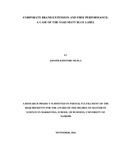| dc.description.abstract | The brand concept has come a long way especially during the product marketing times, where branding and management of brands played a huge role in creating differentiation and product preference in consumers’ mind. Brand extensions newly introduced maximizes on brand name equity already established. Core brand names that customers are familiar with aid products newly entering the market and enable them quickly capture new market segments. Locally, there lacked studies addressing strategies for brand extension. The gap needed for a study to be developed that looks into how strategies on brand extension affects local firm performance. Brand extension strategies are often used in international markets. This research therefore sought to investigate the relationship between brand extension and firm performance in the case of The Nakumatt Blue Label. A customer’s decision to accept a brand extension is determined by several factors. the ability of a brand extension to fit into a parent brand is the most widely acknowledged factor. There is an increased embrace of the implicit theory roles of the self to interpret and understand human behavior by social and cognitive psychologists. The theory of associative-network memory is the overarching theory for comprehension of evaluations concerning brand extension and their impacts on feedback. A consumer capability to have brand knowledge in their memory is recognized schema, a brand information nodes network. According to literature, a parent brand, initially evaluated directly and positively affects evaluation of a brand extension, by clients. In entity theory, fixed features include ability, moral and intelligence while the theory of incremental perceive that there will be changes in the aspects. The former views intelligence as a trait despite learning new things, it remains fixed the latter are of the view that intelligence level is bound to change as they put more effort into it. As a result of these different perceptions, there is a probability of the entity theory to translate into a presumably negative personality change. This study used a descriptive research method and a case study design. The researcher used a questionnaire for data collection. From the study findings, it was clear that Nakumatt sales have grown steadily since introduction of the Blue Label. The researcher also established that this growth is attributable relatively to introduction of the Blue Label. This implies that the introduction of the Blue Label has been responsible for sales growth directly at Nakumatt. Therefore, it has been established that there is a relationship between Blue Label categories growth and general sales growth. This means that there is high evidence that for Nakumatt to strengthen its sales position, it is imperative that they strengthen the category strength of the Blue Label products within each individual category. Based on the findings of the study, the researcher concludes that since Nakumatt sales have grown steadily since introduction of the Blue Label, it is implied that the introduction of the private label has immensely benefited the sales baseline of Nakumatt, and therefore that corporate brand extension and firm performance are not only correlated, but also have a positive relationship. | en_US |



